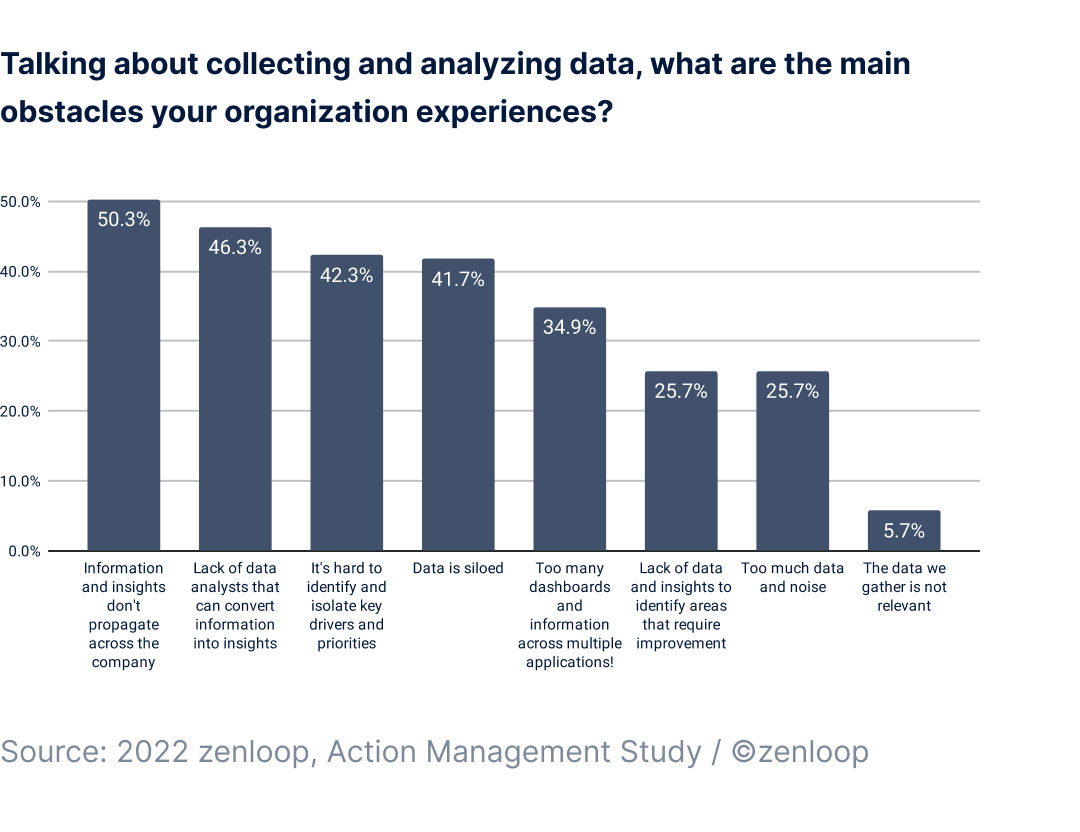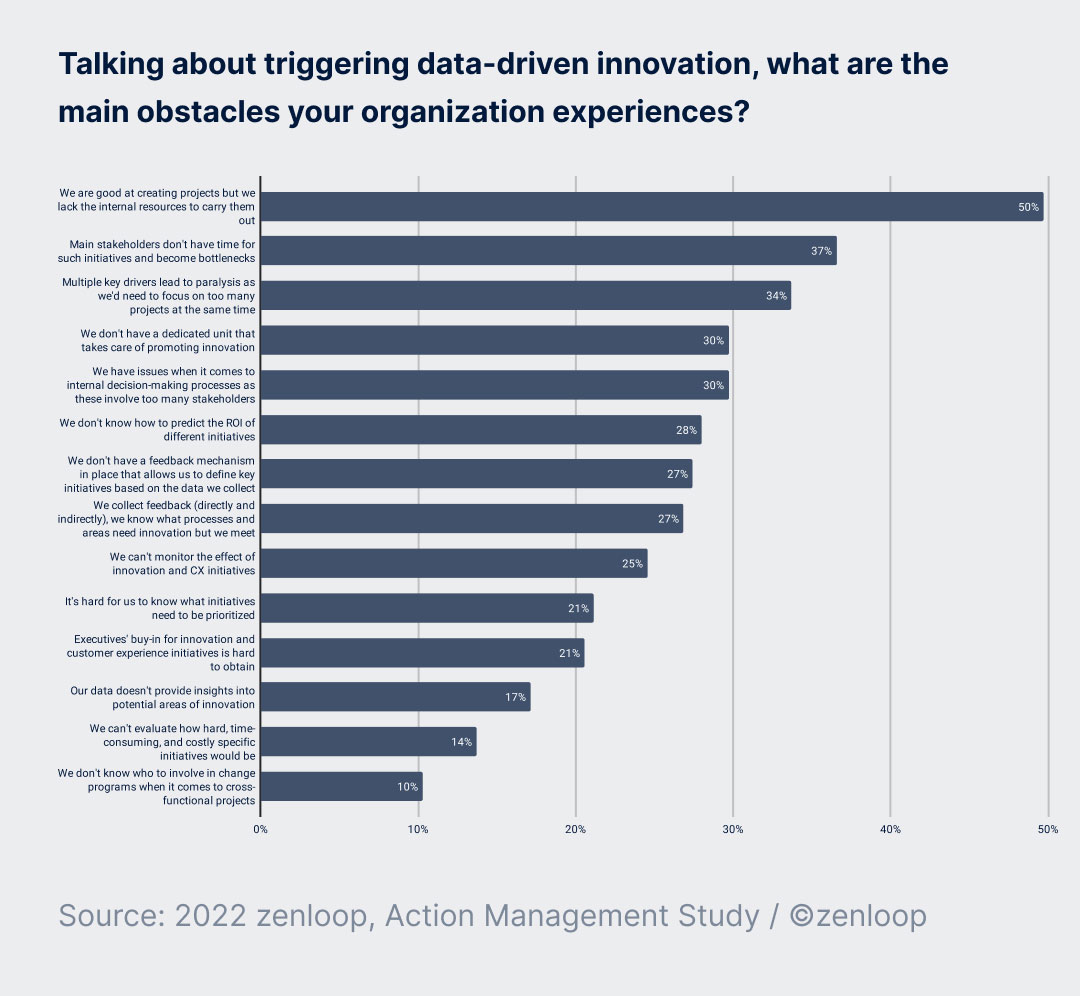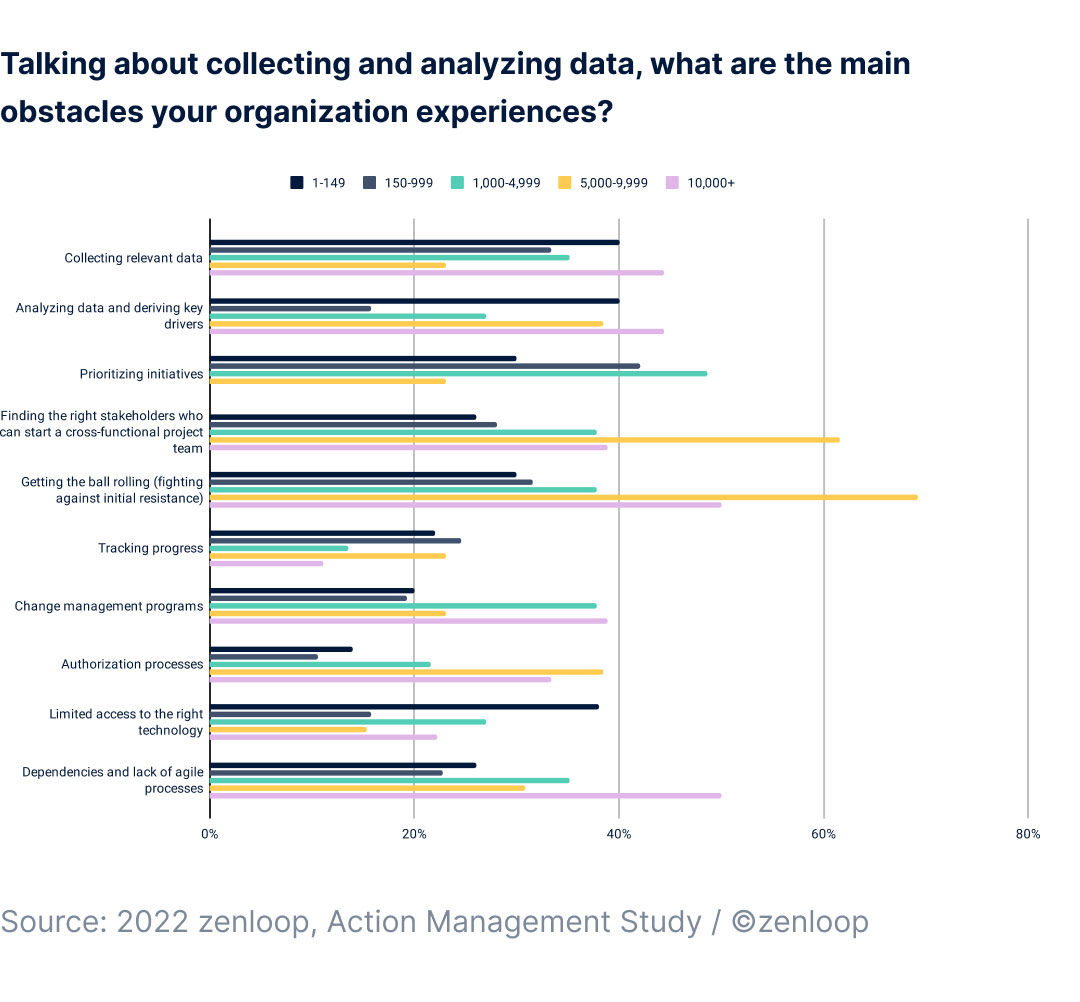CX Action Management Study Part 2
Main Customer Experience Challenges Revealed
It’s no secret that CX is a top priority for businesses today, especially when 86% of consumers are willing to pay more for a great customer experience. Despite this, many businesses still struggle to transform customer feedback into actions and provide an exceptional experience for their customers. We asked 350 CX professionals to reveal their main day-to-day challenges with their CX operations. You may be surprised by the findings.
Action Management Study Recap
- The Action Gap: In early 2022, zenloop decided to develop an Action Management System to tackle the Action Gap – the challenge of customer feedback not being translated into actionable measures.
- Research and Purpose: To develop their new system and link Action Management with specific internal processes, zenloop conducted interviews with 350 experts and CX leaders from 25 countries to validate hypotheses and measure how effective companies are when reacting to customer feedback.
- Survey: The topics covered in the survey included: how reactive companies are to customer feedback, how companies collect and manage insights, and what the main obstacles of customer-driven actions are.
- Results: The study showed that there is indeed a disconnect between customer thoughts and company actions, causing many organizations to struggle with translating customer feedback into meaningful initiatives. See below for results and highlights.
Main Obstacles Within the Entire CX Process
The main challenges companies confront at various stages of the Action Management process:
Capturing and Analyzing Customer Data
When examining the most significant obstacles companies experience when collecting and analyzing customer data, the inability to propagate information across the company poses the biggest problem (50% of responses) – followed by difficulties analyzing data (46%), and in third place, the issue of siloed data (42%).
Main factors impacting data collection and analysis:
- Communication breakdowns (failure to circulate insights internally)
- No automation (data is manually analyzed)
- Siloed data (no follow-up on customer feedback campaigns)
These are followed by: (4) too many dashboards, (5) lack of data, (6) too much data, and (7) irrelevant data.
Data-Driven Innovation Management
Triggering data-driven innovation and customer-centric initiatives is a crucial aspect of Action Management. The most voiced challenges companies face are a lack of internal resources to implement projects (50% of respondents), various stakeholder bottlenecks (37%), and focusing on too many projects at the same time (34%).
Main factors impacting data-driven innovation:
- Internal resources (lack of dedicated people to carry out projects)
- Stakeholders as bottlenecks (no key stakeholder buy-in or little prioritization)
- Data overflow and paralysis (poor prioritization/focus managing multiple projects)
Other obstacles in this area include: (4) no dedicated units, (5) too many stakeholders, (6) calculating ROI of CX, (7) poor feedback process, (8) monitoring effectiveness, (9) general prioritization issues, and (10) executive disinterest in CX initiatives.
Speed To Action
When acting on customer feedback, the most time-consuming areas are prioritizing initiatives (37% of respondents), fighting against internal resistance to getting projects started (37%), and attempting to collect the right data (36%).
Main factors impacting velocity and speed to action:
- Prioritization (what initiatives to address first)
- Internal resistance (butting heads with execs to get projects started)
- Data relevancy (taking the time to collect and analyze relevant data)
Other obstacles in this area include (4) identifying the right stakeholders, (5) lack of agile processes, (6) change management, (7) limited access to the right tech, (8) progress tracking, and (9) authorization processes.
Transforming Customer Data Into Insights
Although companies of different sizes face different challenges when converting customer data into insights – they do share some common challenges. The most significant is the inability to isolate insightful learnings from an abundance of data, moving from siloed to centralized information and leaving data to collect dust in presentations/dashboards instead of turning them into action plans.
Main factors when transforming customer information into insights:
- Isolating insights (collecting too much data to extract important information)
- Silo to centralization (moving away from limited information access to all access)
- Wasted data (leaving data in dashboards and presentations without any connected actions)
Other obstacles in this area include (4) misleading/contradictory data, (5) difficulty predicting impact of CX efforts, (6) data validation, and (7) integrating new tech into legacy systems.
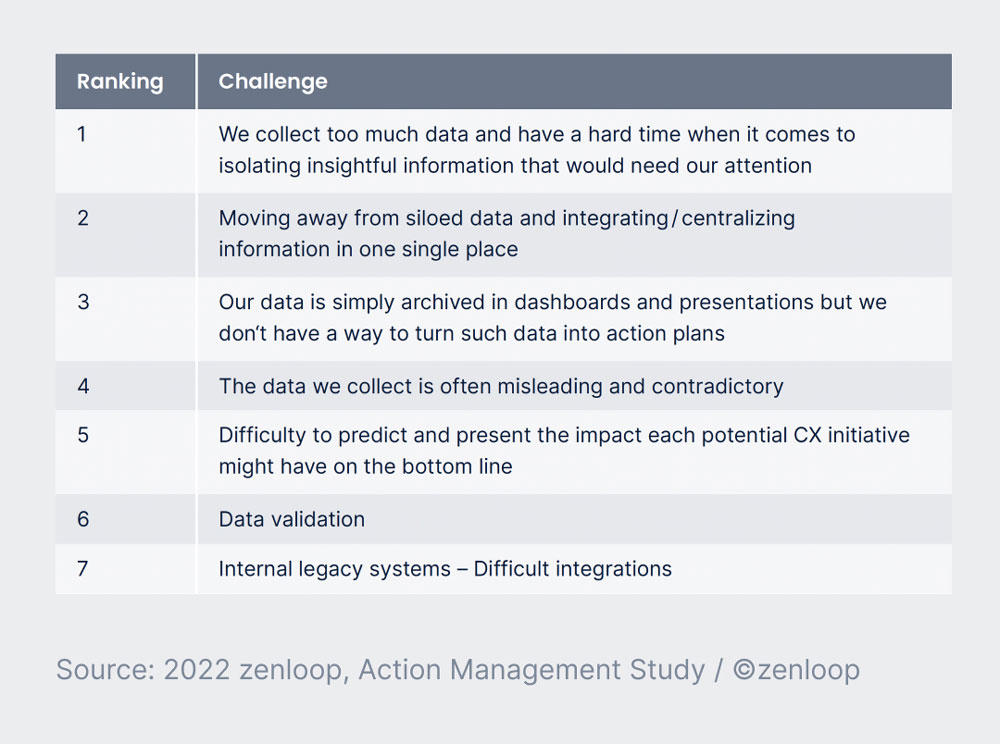
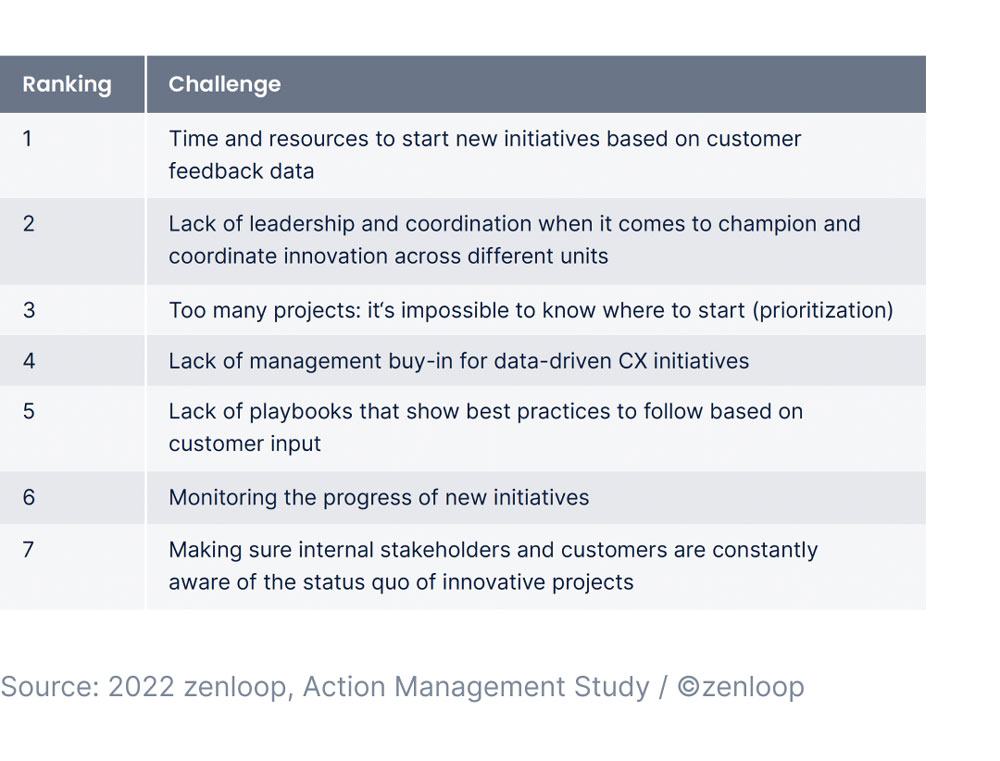
Turning Customer Insights Into Action
After moving from data to insights, the next step in Action Management is the transformation of customer insights into projects and initiatives. When surveyed about the main challenges at this stage, companies of different sizes ranked their pain points in different order – but the obstacle frequently ranked as number one was lack of time and resources (47% of the time), which was also ranked in the top three (81% of the time).
Main factors when turning customer insights into action:
- Lack of time and resources (to start new initiatives based on customer feedback)
- Lack of leadership (championing and coordinating customer innovation across units)
- Too many projects (decision paralysis when prioritizing and starting new projects)
Other obstacles in this area include (4) lack of management buy-in, (5) absence of playbooks and best practices, (6) progress monitoring, (7) informing stakeholders and customers of ongoing initiatives.
General Pain Points for CX Professionals
Participants in the Action Management Study were asked to express their wishes and expectations to help improve their current CX operations. Here are the results:
What do customer experience professionals and CX units wish for?
- A more customer-centric approach organization-wide
- More attention and commitment from the management team
- Executive teams to take CX insights as seriously as commercial/ performance data
- More robust infrastructure and increased resources
- Smarter incentives to motivate customers to provide feedback
- Better quality and more relevant data
- More centralized customer data – even if collected through different channels
What do customer experience professionals and CX units expect?
- More automation and a more simplified overview of CX KPIs
- More relevant and customized real-time information
- Data centralization and more intelligent systems
- Seamless and effortless ways for customers to provide feedback
- Fewer dashboards and a single source of truth
Expectations: Action Management Platforms
What do CX professionals want from an Action Management platform?
An integrated recommendation engine to help:
✓ Prioritize projects
✓ Choose best practices
✓ Improve data quality and quicker insight discovery
✓ Create projections (impact and ROI)
✓ Manage outcomes
An intelligent system to help:
✓ Increase speed-to-action from data to initiatives
✓ Involve and engage with the right stakeholders
✓ Automatically trigger A/B tests for projects
✓ Monitor the effectiveness of projects and initiatives
In Summary:
- Companies face many challenges when it comes to CX, such as internal communication breakdowns, lack of automation, and siloed data.
- Data-driven innovation is crucial, but companies often lack the internal resources or focus to carry out projects successfully.
- Speed to action can be a challenge when attempting to prioritize initiatives or collect relevant data.
- Transforming customer data into insights can be difficult if there is too much data or it is not centralized.
- Turning customer insights into action is an uphill battle if there is a lack of time and resources, stakeholder commitment, or management buy-in.
Companies need to take a new approach when managing their customer experience. The current system is not working because it does not allow companies enough time or resources to close the feedback loop and fix the action gap.
By using an Action Management Platform designed specifically for this purpose, companies can use customer insights to improve products, processes, and services while also delighting customers along the way – and even turning them into loyal fans of your business.
Want to utilize Action Management for your business?







